
The willow beauty is a moth of the family Geometridae. It is a common species of Europe and adjacent regions. While it is found widely throughout Scandinavian countries, which have a maritime climate, it is absent from parts of the former USSR which are at the same latitude but have a more continental climate.

The white-shouldered house moth is a species of gelechioid moth. It belongs to the subfamily Oecophorinae of the concealer moth family (Oecophoridae), just like the brown house moth. Though several presumed congeners of E. sarcitrella were described, its genus Endrosis is currently understood to be monotypic.

Lomographa bimaculata, the white-pinion spotted, is a species of geometer moth. It belongs to the large geometer moth subfamily Ennominae, and therein to the tribe Baptini. It is – under its junior synonym – the type species of its genus Lomographa. It is also the type species of Bapta, a junior objective synonym of Lomographa and the namesake of the Baptini. The species was first described by Johan Christian Fabricius ion 1775.

Orthonama obstipata, the gem, is a moth of the family Geometridae. The species was first described by Johan Christian Fabricius in 1794. It is a cosmopolitan species. In continental Europe though in the northeast, its range does not significantly extend beyond the Baltic region and it is absent from northern Russia. This well-flying species is prone to vagrancy and able to cross considerable distances of open sea; it can thus be regularly found on the British Isles and even on Iceland.

Argyresthia curvella is a species of ermine moth. It belongs to subfamily Argyresthiinae, which is sometimes elevated to full family rank in the superfamily Yponomeutoidea. It is commonly called apple blossom tineid, reflecting the fact that it was originally believed to be a tineid moth.
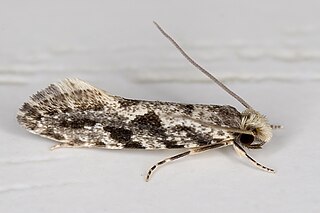
Nemapogon granella is a species of tineoid moth. It belongs to the fungus moth family (Tineidae), and therein to the subfamily Nemapogoninae. It is the type species of its genus Nemapogon, and via that also of the subfamily Nemapogoninae. It is also the type species of the proposed genera Brosis and Diaphthirusa, which are consequently junior objective synonyms of Nemapogon.

The brown-dotted clothes moth is a species of tineoid moth. It belongs to the fungus moth family (Tineidae), and therein to the nominate subfamily Tineinae. It is the type species of its genus Niditinea.
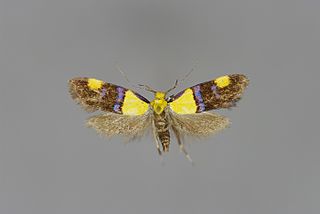
Oecophora bractella is a species of gelechioid moth. It belongs to the subfamily Oecophorinae of the concealer moth family (Oecophoridae). As the type species of its genus Oecophora, its affiliations and phylogeny determine the delimitation of that family and subfamily.

Pseudatemelia flavifrontella is a species of gelechioid moths.

Orthonama is a genus of the geometer moth family (Geometridae). It belongs to the tribe Xanthorhoini of the "carpet" subfamily (Larentiinae). Nycterosea is usually included here by modern authors, but may in fact be distinct enough to warrant recognition as an independent genus. The genus was erected by Jacob Hübner in 1825.
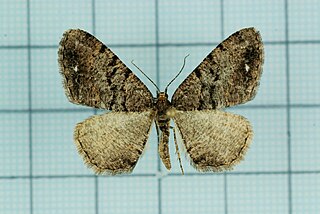
Parectropis is a genus in the geometer moth family (Geometridae). A small Old World genus, it contains only a good dozen species altogether, though new ones are still being discovered. Only one species is found in Europe; most others live in Asia though some occur in Africa.
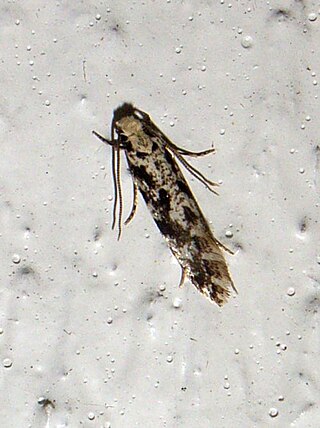
Nemapogon is a genus of the fungus moth family, Tineidae. Therein, it belongs to the subfamily Nemapogoninae. As evident by its name, it is the type genus of its subfamily.

Nemaxera is a genus of the fungus moth family, Tineidae. Therein, it belongs to the subfamily Nemapogoninae. The genus is considered monotypic, with the single species Nemaxera betulinella placed here.

Tinea trinotella is a species of tineoid moth. It belongs to the fungus moth family (Tineidae), and therein to the nominate subfamily Tineinae. It was once used as type species of a distinct genus Acedes, but this is synonymized today with Tinea, the type genus of Tineinae, Tineidae and the superfamily Tineoidea.

Grapholita is a large genus of tortrix moths. It belongs to subfamily Olethreutinae, and therein to the tribe Grapholitini, of which it is the type genus.

Cnephasia is a genus of tortrix moths. It belongs to the subfamily Tortricinae and therein to the tribe Cnephasiini, of which it is the type genus.

Esperia is a genus of the concealer moth family (Oecophoridae). Among these, it belongs to subfamily Oecophorinae. Most authors include Dasycera here, though approaches that generally follow a "splitting" approach sometimes do not.

Denisia is a genus of the concealer moth family (Oecophoridae). Among these, it belongs to subfamily Oecophorinae. It was originally established as a subgenus of Borkhausenia.
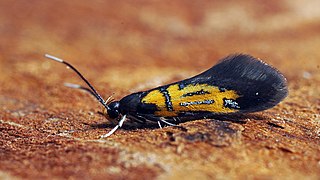
Schiffermuelleria is a genus of gelechioid moths. It is placed in the subfamily Oecophorinae of family Oecophoridae. The genus is treated as monotypic, with the single species Schiffermuelleria schaefferella placed here. As such, its distinctness from the closely related genus Borkhausenia – where S. schaefferella was often placed in the past – is open to debate.

Tinea is a genus of the fungus moth family, Tineidae. Therein, it belongs to the subfamily Tineinae. As evident by its name, it is the type genus of its subfamily and family. Established as one of the first subgroups of "Phalaena", it used to contain many species of Tineidae that are nowadays placed in other genera, as well as a few moths nowadays placed elsewhere.




















